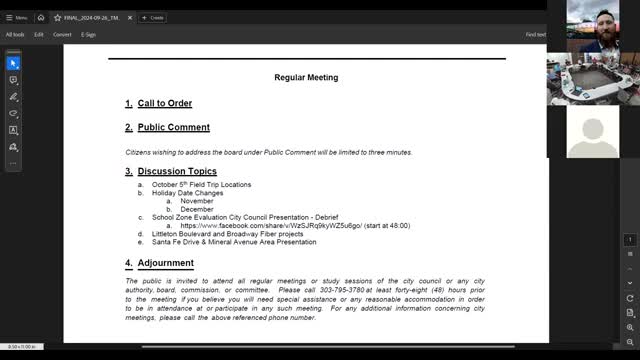City leaders push for safer school zones and bike lanes
September 30, 2024 | Littleton City, Arapahoe County, Colorado
This article was created by AI summarizing key points discussed. AI makes mistakes, so for full details and context, please refer to the video of the full meeting. Please report any errors so we can fix them. Report an error »

In a recent government meeting, officials discussed the pressing need for enhanced safety measures around school zones, emphasizing the importance of addressing not just the immediate vicinity of schools but also the broader areas that students traverse to reach them. Concerns were raised about the safety of routes extending from children's homes to school entrances, highlighting the necessity for a comprehensive approach to ensure safe passage for students.
Participants acknowledged that while efforts have been made to secure federal funding for major school corridors, the challenge remains in effectively communicating plans for these buffer zones. The conversation underscored the complexity of urban planning, where a mile radius around schools encompasses the entire city, necessitating a city-wide commitment to improving safety for young pedestrians.
The discussion also touched on the city's transportation master plan, which has not been updated since 2019. Officials recognized the need for a revised strategy that reflects changes in transportation dynamics post-pandemic. They noted that while the city has historically approached planning from a broad perspective, there is now an opportunity to focus on specific areas, particularly those surrounding schools.
Pilot projects were highlighted as a practical solution to test new safety measures without significant upfront investment. These initiatives allow for community feedback and adjustments before permanent implementations are made. Officials expressed optimism that these pilot projects would lead to tangible improvements in infrastructure, including protected bike lanes and safer crossings.
The meeting concluded with a commitment to collaborate with neighboring jurisdictions, such as Centennial, to enhance safety measures across shared routes. As the city moves forward, officials are hopeful that these discussions will translate into actionable plans that prioritize the safety of its youngest residents.
Participants acknowledged that while efforts have been made to secure federal funding for major school corridors, the challenge remains in effectively communicating plans for these buffer zones. The conversation underscored the complexity of urban planning, where a mile radius around schools encompasses the entire city, necessitating a city-wide commitment to improving safety for young pedestrians.
The discussion also touched on the city's transportation master plan, which has not been updated since 2019. Officials recognized the need for a revised strategy that reflects changes in transportation dynamics post-pandemic. They noted that while the city has historically approached planning from a broad perspective, there is now an opportunity to focus on specific areas, particularly those surrounding schools.
Pilot projects were highlighted as a practical solution to test new safety measures without significant upfront investment. These initiatives allow for community feedback and adjustments before permanent implementations are made. Officials expressed optimism that these pilot projects would lead to tangible improvements in infrastructure, including protected bike lanes and safer crossings.
The meeting concluded with a commitment to collaborate with neighboring jurisdictions, such as Centennial, to enhance safety measures across shared routes. As the city moves forward, officials are hopeful that these discussions will translate into actionable plans that prioritize the safety of its youngest residents.
View full meeting
This article is based on a recent meeting—watch the full video and explore the complete transcript for deeper insights into the discussion.
View full meeting
